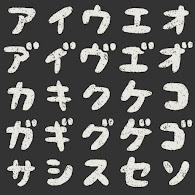Japanese Level 1, Activity #6: “Katakana” / “カタカナ” (Face-to-Face)

Image via Irasutoya
Description:
The students will have a selection of different games to practice katakana with. Start with bingo to practice the basic characters and prepare the students for more difficult games. Then, choose either the matching game or the hangman game to practice entire katakana words with the students. If time permits, you can transition into whichever game you have not already played.
Katakana, loan words, games, カタカナ, ローンの言葉, ゲーム, これ/それ/あれ/どれ, この/その/あの/どの+Noun, この/その/あの/どの+名詞, ここ/そこ/あそこ/どこ, だれのNoun, 誰の名詞, Nounも, 名詞も, Nounじゃないです, 名詞じゃないです, 〜ね/〜よ
Practices: When to use Katakana
Perspectives: Katakana as a masculine writing system
NCSSFL-ACTFL World-Readiness Standards
- Standard 1.1: Students engage in conversation, provide and obtain information, express feelings and emotions, and exchange opinions.
- Standard 1.2: Students understand and interpret written and spoken Japanese on a variety of topics.
- Standard 2.1: Students demonstrate an understanding of the relationship between the practices and perspectives of Japanese culture.
- Standard 4.1: Students demonstrate understanding of the nature of language through comparisons of the Japanese language and their own.
Idaho Content Standards for World Languages:
- COMM 1.1: Interact and negotiate meaning (spoken, signed, written conversation) to share information, reactions, feelings, and opinions
- COMM 2.1: Understand, interpret, and analyze what is heard, read, or viewed on a variety of topics.
- COMP 1.1: Observe formal and informal forms of language.
- COMP 1.2: Identify patterns and explain discrepancies the sounds and the writing system in the target language.
NCSSFL-ACTFL Can-Do Statements
- I can recognize individual katakana.
- I can understand loan words written in katakana.
Materials Needed
- Google Presentationhttps://docs.google.com/presentation/d/1CYUzMIswajqp_t45eWoJQjxx8XocXr2Is195H1upqWY/edit?usp=sharing
- Katakana List
- Katakana Bingo Cards
- Katakana Poster
- Katakana Cards
- Katakana Hangman Prompts
- Markers
Would you like to make changes to the materials? Access the template(s) below:
(Canva Template, free account required)
Warm-Up:
Pull up the presentation and greet your students in Japanese.
プレゼンテーションを開けて、日本語で学生に挨拶します。
Move to the next slide with the “Can-Do Statements” and read each Can-Do statement in English.
「Can-Doステートメント」のスライドに移動し、Can-Doステートメントを英語で読みます。
Katakana Bingo: Start with katakana bingo to ease the students into the more difficult games later.
カタカナビンゴ:カタカナビンゴから始めて、後で学生がビンゴより難しいゲームに参加できるようにします。
- ビンゴをしましょう!
Give each student a Katakana Bingo Card.
学生にカタカナビンゴのカードを渡します。
To play the game, randomly choose katakana from the bingo list to call out.
ビンゴリストからランダムにカタカナを選んで呼び出します。
If any students have that katakana on their card, have them cross that katakana off with a marker.
カードにそのカタカナがある学生がいる場合は、マーカーでそのカタカナに印を付けてもらいます。
For the first character, make sure the students understand the game.
ゲームのやり方が分かるか確認します。
- 例えば:最初は「フ」です。誰か「フ」がありますか?
If they have 「フ」, make sure they cross it out.
「フ」があれば、×で印をつけます。
The first to get five-in-a-row wins! Once a student wins, have them read out which ones they got! (So we can also check if they really did get them.)
最初の5連続ができた人は勝ちます。学生が勝ったら、どれに印を付けたかを読んでもらいます。(確認のためです)
Main Activity:
There are two options for the main activity. Pick the option that best suits your students. If time permits, you can have your students play both games.
活動には2つのオプションがあります。学生に最適なオプションを選んでください。時間があれば、学生に両方のゲームをやることができます。
Hangman:
- 次のゲームはハングマンです。
Model the activity for the students. A student will randomly pick a hangman card with a word in katakana and a little picture to help.
学生の活動を示します。学生は、カタカナの単語のカードをランダムに選びます。
Draw a word from the bag and unfold it
- 袋から単語のカードを取ってください。
Show the students the word and point to the board
- ここにブランクを描いてください。
- 例えば:言葉が「ボール」だったら、三つのブランクを描きます。
- みんな、分かりますか?
Once the students understand, choose a writer.
- ボランティアはいますか?
Once the students have correctly guessed the word, choose a new writer and give them the next hangman card.
- もう一人ボランティアがいますか?
Repeat!
Matching:
Have the students pair up. For groups of students larger than six, just make sure there are three groups.
学生にペアを組ませます。 6人以上がいれば、3つのグループがあることにしてください。
- みんな、ペアになってください。
Give each pair (or group) one of the three katakana posters.
ペア(またはグループ)に3つのカタカナポスターの1つを渡します。
Give each group the eight katakana cards that correspond to their poster. There are orange, purple, and blue cards. The correct cards should be pinned to the correct poster, but the color will be written on the back of the poster.
グループに、ポスターに対応する8枚のカタカナのカードを渡します。オレンジ、紫、青のカードがあります。カードは正しいポスターに固定しているはずですが、色はポスターの後ろに書いてあります。
Students should match the words on the cards to the picture on the poster.
カードの単語をポスターの対応する絵に置いてもらいます。
Model the game for the students using one of the matching cards and its corresponding poster.
カードの1つとそれに対応するポスターを使用して、ゲームのやり方を示します。
Grab the violin card. Match it to the violin picture.
- 例えば:「バイオリン」カードを持って、バイオリンの写真を見つけてください。
When they are finished, check for correctness and rotate the posters and cards.
終わったら、正しさを確認し、ポスターとカードを回転させます。
Each group should have a chance to match each poster.
各グループは、各ポスターと一致する機会を持つべきです。
wrap up:
Have each student write down 1 word in Katakana.
各生徒にカタカナで単語を 1 つずつ書いてもらいます。
End of Activity:
- Read Can-Do statements once more and have students evaluate
their confidence. - (Use thumbs up/thumbs down or download our student cards.)
- Encourage students to be honest in their self-evaluation.
- Pay attention, and try to use feedback for future activities!
NCSSFL-ACTFL Can-Do Statements
- I can recognize individual katakana.
- I can understand loan words written in katakana.

